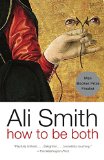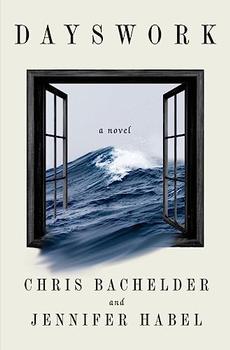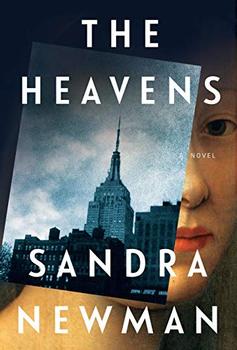Summary | Excerpt | Reading Guide | Reviews | Beyond the book | Read-Alikes | Genres & Themes | Author Bio

Critics' Opinion:
Readers' Opinion:
First Published:
Dec 2014, 384 pages
Paperback:
Oct 2015, 384 pages
 Book Reviewed by:
Book Reviewed by:
Naomi Benaron
Buy This Book
How you see - and experience - Ali Smith's new novel How to Be Both (which won the 2014 Costa Novel of the Year Award) is a matter of chance. Inside are two intertwined stories. One, titled "one," is narrated by Francesco del Cossa, a 15th century Italian artist; the other, also titled "one," is in the voice of George, a charmingly brilliant and rebellious twenty-first century teenage girl struggling to deal with the sudden death of her mother. The order of the stories is random; half were printed with del Cossa'a story first, half the other way around.
"I had been hovering for some time round an idea for the structure of a new novel," Smith stated in an article she wrote in The Guardian about the inspiration for How to Be Both. Speaking of a book she found about frescoes in Florence that when damaged had revealed the original "underdrawings," she said, "I'd been wondering if it might be possible to write a book consisting of something like this structure of layer and 'underlayer,' something that could do both." Indeed, in her new work, Smith accomplishes this. Shortlisted for the 2014 Man Booker Prize and winner of the 2014 Goldsmith Prize, Smith reinvents the structure of the novel, twisting and turning her themes into a Gordian knot unified by the strands of two engaging narratives. It is, in turns, wildly funny, rebelliously political, and painfully honest in its examination of loss and discovery. It is always bold and exquisitely wrought, blurring boundaries of genre, gender, time, and linear story until the reader feels she has entered a funhouse, the floors unpredictably tipping, the walls lined with dazzlingly warped mirrors.
First in my copy of the novel was del Cossa's story, which is loosely based on historical truth. Francesco del Cossa was an artist from the town of Ferrara, most famous for his frescoes in the Palazzo Shifanoia, the Palace of Not Being Bored. Smith saw a detail from one of his frescoes in an art magazine and she says, "found it so beautiful that it did something to my breathing and I nearly choked." The discovery led to a trip to Ferrara; the trip was the seed for How to Be Both.
Smith begins the tale by launching the artist into the twenty-first century: "Ho this is a mighty twisting thing fast as a/fish being pulled by its mouth on a hook/if a fished could be fished through a/six foot thick wall made of bricks." He lands in a room hung with paintings. There is a boy in the room who stands in front of one of the paintings, and the artist notes with pleasure, "that picture he's - it's mine, I did it." Here, Smith turns the notion of gender on its head: in her imagining of the character, del Cossa is female. After the death of her mother, her father convinces her to assume a male identity so that her artistic talent will be recognized. As well, del Cossa soon discovers that the boy she observes and then begins following, is also a girl.
Del Cossa's story slips between the fifteenth century and "purgatorium," as she calls the strange place where, "people dance by themselves . . . by filling their ears with little blocks and swaying about to a silence, or to a noise smaller than the squee of a mosquito that comes through the little confessional grille in each of the blocks." The reader understands this authorial wink; the "blocks" are an iPod. In the fifteenth century, del Cossa plays out the few known details of her life, generously enhanced with the brushstrokes of Smith's invention. The character she creates paints portraits of prostitutes she befriends, falls in love with women and men, and comes to question the norms of class and justice. In "purgatorium," she observes the girl who, one soon guesses, will reappear in the other part of How to Be Both. These observations form a sort of "underlayer" beneath the fresco of del Cossa's tale, the sketches that exist beneath the fresco of the "second" story.
The second book "one" begins with a girl named George, her younger brother Henry, and her mother who are driving to Ferrara to see the frescoes at the Palazzo Shifanoia. George, it soon becomes clear, is, indeed, the girl del Cossa observed. It will be their last trip together – her mother dies from an allergic reaction to an antibiotic.
Here, Smith weaves between time before and after the death of George's mother, her existence continuing as an "underlayer" of her absence. In the world without her mother, George flounders, spiraling toward a state of hopelessness. Her father is largely absent and often drunk, leaving her to care for her brother. But George is not a quitter. She fills her walls with photographs of her mother. She starts her mornings by performing the "sixties dance" her mother used to exercise to. In a gesture parallel to del Cossa's portraits of prostitutes, she daily watches some portion of a porn film she found online of a young girl who appears drugged and is having sex with an older man. She explains to her father that she is, "doing it in witness, by extension, of all the unfair and wrong things that happen to people all the time." This act of witness, Smith seems to say, is George's way of turning injustice into art.
Had I read George's story first, my "seeing" of del Cossa's tale would have been entirely different. Like the beam of a flashlight, the reader's vision depends on whether George shines on del Cossa from the rear or the front. Whichever way you read it, How to Be Both is a wide-eyed look at the world's magic. It is breathless with both joy and sorrow, with the miracle of being alive and the grief of someone you love being taken suddenly from the living. "So always risk your skin, and never fear losing it," Francesco del Cosa's mother tells her. Indeed, Ali Smith has risked her skin with her bold reimagining of the novel. And indeed, we are the better for it.
![]() This review was originally published in The BookBrowse Review in January 2015, and has been updated for the
November 2015 edition.
Click here to go to this issue.
This review was originally published in The BookBrowse Review in January 2015, and has been updated for the
November 2015 edition.
Click here to go to this issue.

If you liked How to be Both, try these:

by Chris Bachelder, Jennifer Habel
Published 2024
A startlingly original, incantatory novel about marriage, mortality, and making art.

by Sandra Newman
Published 2019
Transporting the reader between a richly detailed past and a frighteningly possible future, The Heavens is a powerful reminder of the consequences of our actions, a poignant testament to how the people we love are destined to change, and a masterful exploration of the power of dreams.





The House on Biscayne Bay
by Chanel Cleeton
As death stalks a gothic mansion in Miami, the lives of two women intertwine as the past and present collide.

The Flower Sisters
by Michelle Collins Anderson
From the new Fannie Flagg of the Ozarks, a richly-woven story of family, forgiveness, and reinvention.

The Funeral Cryer by Wenyan Lu
Debut novelist Wenyan Lu brings us this witty yet profound story about one woman's midlife reawakening in contemporary rural China.
Your guide toexceptional books
BookBrowse seeks out and recommends the best in contemporary fiction and nonfiction—books that not only engage and entertain but also deepen our understanding of ourselves and the world around us.